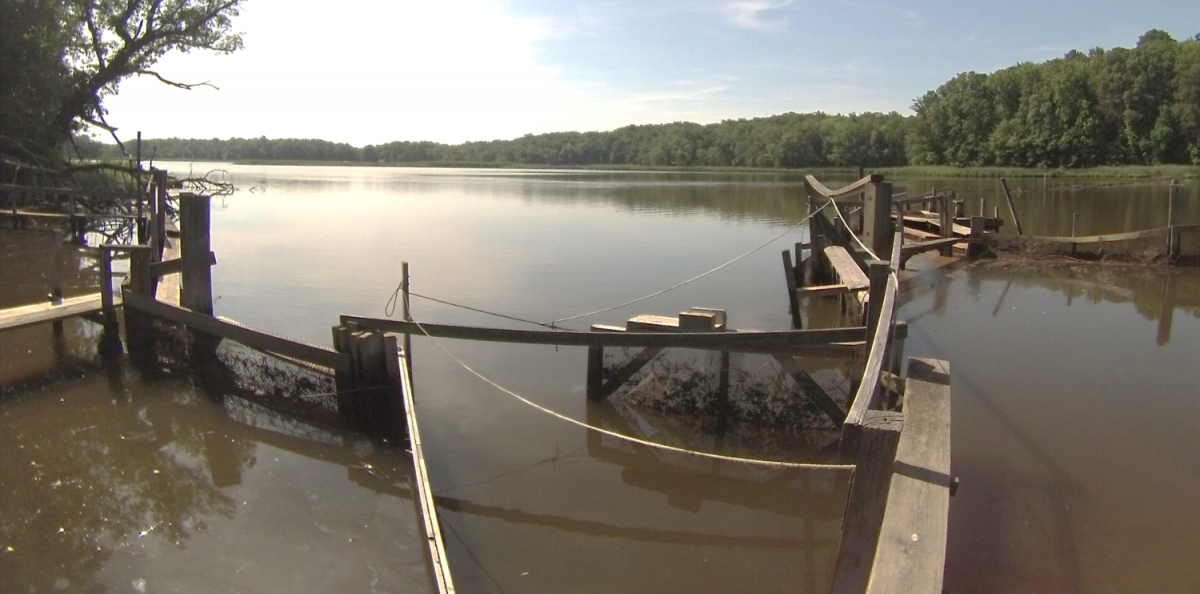Fish and Crustaceans in a Tributary Creek
Project Goal:
The goal of this project is to understand the value of small tidal marsh creeks for fish, crustaceans and other species.

Muddy Creek: a Small Tributary of the Rhode River
The Rhode River System is a small tributary of the Rhode River located approximately 200 km (120 miles) north of the mouth of the Chesapeake Bay in Edgewater, Maryland. Salinity in the creek ranges from 0.5 (nearly freshwater) to 18 (half the salinity of the ocean), a range characteristic of the oligohaline/mesohaline zones of the estuary. Salinity fluctuations are primarily dependent upon local precipitation and major flood events of the Susquehanna River. The creek is fringed by Spartina-and Phragmites-dominted marsh, hardwood forest, adjacent agriculture, private development, and the sediments are primarily fine sand and mud. The Rhode River experiences semi-diurnal tides with an amplitude of approximately 1 meter. Water temperatures cycle seasonally between 0o in January when the creek sometimes freezes over and 30-330C in July.
Small tidal marsh creeks such as Muddy Creek provide habitat for many species of fish and invertebrates. These habitats are used for spawning by white perch, as refuge from predators for male blue crabs molting to maturity, and nursery grounds for a number of fish, reptiles, and amphibians. Our lab has been examining the population dynamics and community structure of such organisms in Muddy Creek since 1983. We use a weir in order to see what is using the creek.

The Fish Weir
The weir is a series of v-shaped fences that span the mouth of Muddy Creek as it enters the Rhode River. The fences help direct organisms moving along the creek into nets. Fish, invertebrates, and other organisms are funneled into two openings, one facing upstream, and the other facing downstream. Once each week, nets are deployed at the two openings for a period of 24 hours. Organisms traveling both upstream and downstream are thus collected during a full tidal cycle and day night cycle. All captured individuals are identified to the species level and enumerated while a subset of 20/species is measured. When the nets are not deployed, a gate located in the center of the weir is opened to allow fish and crabs (and kayakers) to pass freely.

What's Using Muddy Creek?
Since 1983, 133 species of fish, invertebrates, amphibians, reptiles, birds (ducks) and mammals have been collected by the weir. Most species occur at relatively low abundances. However, five species of fish account for over 92% of the total catch: Mummichog (Fundulus heteroclitus), Atlantic Menhaden (Brevoortial tyrannus), Atlantic Silverside (Menidia menidia), Sheepshead Minnow, and Spot (Leiostomus xanthurus).
Other frequently encountered species include White Perch (Morone americana), blue crab (Callinectes sapidus), Striped Killifish (Fundulus majalis), Bay Anchovy (Anchoa mitchilli), Striped Bass (Morone saxatilis), Pumpkinseed (Lepomis gibbosus), Green Sunfish (Lepomis cyanellus), Common Carp (Cyprinus carpio), Brown Bullhead (Ameiurus nebulosus) and Gizzard Shad (Dorosoma cepedianum).
















